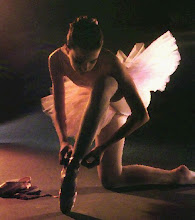
Desirable physical characteristics for a ballet dancer include long arms and legs, a long neck, and a comparatively short torso. The ideal body for ballet is flexible, slim, and strong. Dancers cannot change their body proportions, but they can develop most other desirable physical features by proper training. Every great dancer began with a less than perfect body for ballet.
Ideal dancers also have certain mental characteristics. They have a feeling for rhythm and an understanding of music. They are aware of the relationships between objects in space so that they can move exactly in any direction on the stage. Like good actors, they can express a mood and make a character believable. Above all, they love ballet and dedicate themselves to it completely. Otherwise, they could not train their bodies to move beautifully and expressively in unnatural ways.
Some ballet schools do not accept beginners whose physical and mental characteristics differ too much from those of the ideal dancer. Most of these schools are operated by ballet companies, which train students for work in their organizations. The schools give children a complete physical examination to make sure nothing is seriously wrong with their bodies. Most of them also test the beginners' feeling for rhythm and space relationships. Expressive abilities are harder to discover.
The professional ballet dancer's ideal body is identified by the following:
· Proper proportions - Small head, long neck, shortened torso, long, thin, lean (not emaciated) and attractive legs. Less acceptable aesthetically is long torso, short legs, big buttocks, swayback, round shoulders, spinal curves, big heads and a short neck.
· Loose joints - This could be a matter of genetics or training, either way it is important for the dancer to have enough strength to control motion.
· Turnout of the leg - This is the cornerstone of classical ballet. The turnout begins at the hip and moves down to the knee, tibia, ankle then foot. If hip motion is limited then turnout comes from the floor up. This is more stressful to the knee and other parts of the leg and increases the risk of injury. The ideal dancer is "duck footed" (toes point outward) which is caused by femoral retroversion (leg is naturally angled outward) or anterior capsule stretching (extending flexibility through stretching). Hip version (ability to rotate at the hip) is probably genetically determined and set by age eleven. If it can be changed training needs to begin before this age.
· Slight knee hyperextension - When leg is straight the knee is bent slightly backward. This produces more visually pleasing "S" line of the leg on pointe. It also moves the center of gravity above the knee which gives the dancer's torso and upper body a forward and upward appearance. The dancer must have strength and proper technique to control the knee and avoid injury.
· Genu Varum (bowlegged) - Bowleggedness (riding a horse) is favored for the ballet dancer for both practical and visual reasons. External tibial torsion (outward rotation of the lower leg) is favorable in that it can increase turnout of the leg.
· Adequate plantar flexion of the ankle and foot - A dancer must be able to flex the foot far enough forward to be vertical from knee to toe while on pointe.
· Foot shape - The best foot shape for a dancer is broad and square. This allows forces to be shared by all the metatarsal (foot bones). The first toe must flex 80 to 90 degrees to allow a full releve (from tip of toe to flat foot) and from pointe (standing on toe tip) to demi-pointe (half toe). This flexibility usually results from dancing while the musculoskeletal system is forming.

haaa....good. I was worried I didnt have the right body to be a ballerina, but I do. Phew!
ReplyDeleteThank you for posting this! :)
http://www.revolutionhealth.com/articles/ballet-ideal-body-type/1799
ReplyDeletesomeone lifted your content, word for word.
thanks for the help... research paper:{)
ReplyDeleteI did ballet as a child, which was fine. But as I got older and my body grew and changed, I found it more difficult. One such example is your definition that an ideal ballet dancer has a short torso and long legs. It turns out I'm the opposite: a long torso and short legs. When my leotards stopped fitting, I got a little frustrated. But, the thing is, an ideal doesn't have to be exclusionary. Eventually I was able to find some leos that better fit my proportions and I've been able to continue dancing.
ReplyDeleteIt's not so much your leo's hun... :) as it is for auditions at places like SAB or Vaganova, while some places are more accepting of professional dancers with different propotions, most are still very traditional! Keep up the dancing:)
DeleteMy wife grew up in the Soviet Union. Her parents sent her to ballet lessons against her will. She was only given her physical examination after she'd been there 6 weekday which, interestingly, suggested that although perfectly fit and agile her legs were actually too bulky but her buttocks too small for her to be really successful. Although this didn't preclude her staying on her parents relented and she was allowed to leave!
ReplyDelete